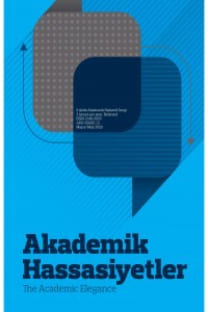ESKİ SOVYET COĞRAFYASINDA YAŞAYAN ETNİK KORELİLER KORYO SARAM
Koryo Saram, Goryo-in, Sovyet Koreli, Güney Kore, Orta Asya, Etnik Koreliler
ETHNIC KOREANS IN THE FORMER SOVIET UNION KORYO SARAM
Koryo Saram Goryo-in, Soviet Koreans, South Korea, Central Asia, Ethnic Koreans, Koreans.,
___
- Banbal, O. (2015). Japon İşgal Döneminde Kore Yarımadası Ve Uzak Doğu’nun Siyasi Görünümü. Yayımlanmış Yüksek Lisans Tezi, Ankara Üniversitesi Sosyal Bilimler Enstitüsü Doğu Dilleri ve Edebiyatları (Kore Dili Ve Edebiyatı) Anabilim Dalı, Ankara.
- Bulut, R. (2014). “SSCB’nin Dağılması Ve Rusya Federasyonu’nda Serbest Piyasaya Geçiş”. Mehmet Akif Ersoy Üniversitesi İktisadi ve İdari Bilimler Fakültesi Dergisi, 1(2),7-13.
- Gelb, M. (1995). “An Early Soviet Ethnic Deportation: The Far-Eastern Koreans”. Russian Review, 54(3), 392-412.
- Huttenbach, H. (1993). “The Soviet Koreans: Products of Russo Japanese Imperial Rivalry”. Central Asian Survey, 12(1), 59–60.
- Hwang, B. (2012). “A New Horizon in South Korea-Central Asia Relations: The ROK Joins the ‘Great Game’ ”. Korea Economic Institute.
- İnternet: Ramani, S. (September, 2015). “South Korea’s Growing Ties With Uzbekistan”. The Diplomat. Web: https://thediplomat.com/2015/09/south-koreas-growing-ties-withuzbekistan adresinden 6 Kasım 2017’de alınmıştır.
- Jo, C. (2006). “Diaspora nationalism: The case of ethnic Korean minority in Kazakhstan and its lessons from the Crimean Tatars in Turkey”. Nationalities Papers, 34(2), 111-129.
- Kho, S. (1987). Koreans in Soviet Central Asia. Helsinki : Finnish Oriental Society.
- Kim, C. (2005). The Hıstory Of Korea. (First edition). United States of America: Greenwood Press, 101.
- Kim, G. (1993). “The History, Culture and Language of Koryo Saram”. Seoul Journal of Korean Studies, 6, 125-151.
- Kim, G. (2002). “Korean Diaspora in Post-Soviet Central Asia: Relations and Attitudes toward North and South Korea”. Korea University and East Rock Institute, 29-43.
- Kim, G. (2003). “Koryo Saram, or Koreans ofthe Former Soviet Union: In the Past and Present”. Amerasia Journal, 29(2).
- Kim, G. (2004). “Koryo Saram in Kazakhstan, Uzbekistan and Russia”. World Diasporas Encyclopedia, 2, 985–993.
- Kim, G. (2009). “Formation and Development of Ethnic Entrepreneurship of Koryo saram in Kazakhstan”. International Area Review, 12(1), 127-162.
- Kim, G. (2017). “Migration vs. Repatriation to South Korea in the Past and Present”. Journal of Contemporary Korean Studies, 4(1), 35-62.
- Kim, G., King, R. (2001). “The Koryo Saram: Koreans in the Former USSR”. Korean and Korean American Studies Bulletin, 12(2-3), 19-45.
- Kim, S. (2001). “A Study on the local autonomy : A case study on the Chipkangso(1894)“. Korean Association For Local Government Studies Abstracts.
- Lee, j., Oh Ki. (1968). The Russian Faction in North Korea. Asian Survey, 8(4), 270-288.
- Li, V. (2012). Lost Koreans: Information Technology and Identity in the Former Soviet Union (Master Dissertation, Arızona State Unıversıty, 2012). Dissertation Abstarct International,1509466.
- Oh, C. (2013). “Soviet Korean (Koryo-in) in Central Asia and Korean Religious Activities in Post-Soviet Central Asia”. Ankara Üniversitesi Dil ve Tarih-Coğrafya Fakültesi Dergisi, 53(2), 211-224.
- Petrov, A. (2008). “Koreans in Russia in the Context of History of Russian Immigration Policy”. International Journal of Korean History, 12(1), 157-197.
- Seth, M. (2016). A Concise History of Modern Korea: From the Late Nineteenth Century to the Present. (Second edition). Rowman & Littlefield Publishers, 14.
- Song, C. Takeshi, T. (2016). “Diasporic Return, Homeland, Hierarchy, and Identity: Experiences of Korean Diasporic Returnees in South Korea”. The University of Auckland Library, 39, 91-116.
- Şimşek, E. (2016). “18. Yüzyılın Sonunda Rusya’nın İskân Politikaları Ve Osmanlı Rumlarının Rusya’ya Göçü”. Tarih İncelemeleri Dergisi, 2, 543-568.
- ISSN: 2148-5933
- Yayın Aralığı: Yılda 3 Sayı
- Başlangıç: 2014
- Yayıncı: A Kitap
ÇOCUK REFAHI ÇALIŞANLARININ TÜKENMİŞLİK VE MESLEKİ DOYUMLARI ÜZERİNE BİR İNCELEME
Rabia ÇOBAN KAYNAK, Rıza GÖKLER
KOSGEB GİRİŞİMCİLİK PROGRAMI: ELEŞTİREL BİR DEĞERLENDİRME
Mete Kaan NAMAL, Mustafa KOÇANCI, Beyhan AKSOY
TÜRK PARTİ SİSTEMİNDE PARÇALANMIŞLIK VE SEÇİMSEL DALGALANMALAR
ULUSLARARASI İNSANCIL HUKUKTA İDARİ GÖZALTI VE DEVLET DIŞI SİLAHLI AKTÖRLER
Fatma TAŞDEMİR, Erdinç ÖZDEMİR
MODERN TOPLUMDA SERBEST ZAMANIN İŞLEVİ VE PLANLANMASI
HİZMETKAR LİDERLİK FİRMA PERFORMANSI İLİŞKİSİNDE ÖRGÜTSEL ÖZDEŞLEŞMENİN ARACI ETKİSİ
Elif BAYKAL, Cemal ZEHİR, Mahmut KÖLE
OKUL SOSYAL HİZMETİ BAĞLAMINDA İLKOKUL ORTAOKUL VE LİSE ÖĞRENCİLERİNİN DEVAMSIZLIK PROBLEMLERİ
ULUSLARARASI İNSAN HAKLARI HUKUKU VE DOĞRUDAN DEMOKRASİ ARASINDAKİ ÇATIŞMA: MİNARE YASAĞI
ORTADOĞU’DA BARIŞI TESİS ETMEDE NEO-OSMANLICILIK BİR SEÇENEK OLABİLİR Mİ?
